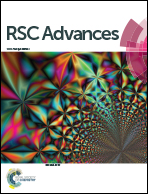Development of a novel H2S and GSH detection cocktail for fluorescence imaging†
Abstract
Hydrogen sulfide (H2S) and reduced glutathione (GSH), which basically represent the two terminals of the reactivity order of small-molecular biothiols, are also the most intriguing signal molecules from this family, and their simultaneous detection is challenging but of great importance to clarify their physiopathology. Herein, we reported a borondipyrromethene (BODIPY) derivative (probe ZS2) equipped with a o-formylchalcone moiety for the simultaneous detection of H2S and GSH in bio-samples. Due to favorable steric and electronic effects, ZS2 can selectively react with H2S and GSH, accompanied by dramatic fluorescence intensity enhancement. When ZS2 is used in combination with our previously reported H2S-specific probe ZS1, the simultaneous and discriminative detection of the highest reactive H2S and the lowest reactive GSH can be realized. As a proof of concept, this detection cocktail has been applied for the quantification of endogenous H2S and GSH in fresh rat plasma, and for their imaging in live cells. Moreover, ZS2 also features a bioorthogonal module which is readily transformed to organelle-specific functionalities. Facilitated by this module, a mitochondria-targeting version, ZS3, was straightforwardly prepared which realized the simultaneous visualization of H2S and GSH localized in the mitochondria.


 Please wait while we load your content...
Please wait while we load your content...